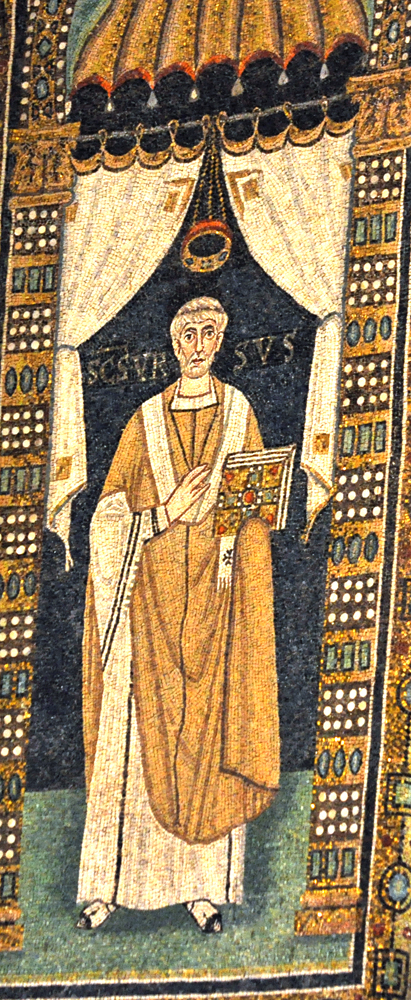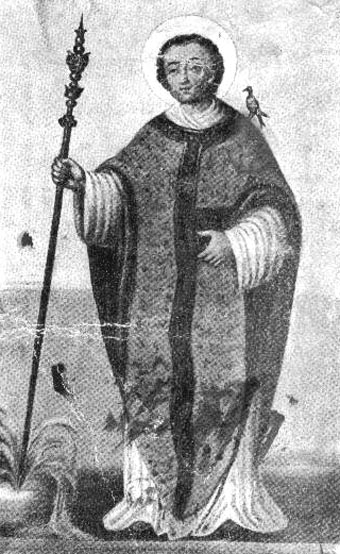-
Saints Victor and Ursus Their story is an extension of the passion of St. Maurice and the Theban Legion, who were martyred in 303 or 305 for refusing to attack Christians. Victor and Ursus managed to escape the slaughter and fled to Solothurn in Gaul, but the authorities caught up with them and they were beheaded. Their bodies floated down the River Aare, holding their heads all the while, and came to a place where the headless bodies knelt in "endless" prayer. In the 10th century Bertha of Swabia built a church on the spot to house their relics.
Earlier images of this St. Ursus have him dressed as a soldier, either standing in contemporary armor (example) or kneeling in the breastplate and aproned tunic of a historical Roman soldier (example). In later images he may simply be a well-dressed contemporary (example).
Thebes being in Egypt, it was traditional to picture St. Maurice as a dark-skinned African; but Ursus and Victor are always presented as white.Hagiography: Acta Sanctorum, September vol. 8, 261-93. For selected passages translated into English, follow this link.
Feast day: September 30. -
St. Ursus of Toul was elected sixth bishop of Toul, in Gaul, in 490. According to Thiery's Histoire de la Ville de Toul, in 496 the Frankish King Clovis completed his conquest of northern Gaul with the Battle of Tolbiac. He had vowed that he would convert to Christianity if he won that battle, so soon afterward as he was passing through Toul he asked Ursus to assign him someone who could instruct him in the faith. Ursus appointed a priest of his church named Waast. By the time Waast and Clovis reached Rheims Clovis was ready to be baptized by St. Remigius.1 Thierry's account is not seconded in Gregory of Tours' 6th-century History of the Franks, where chapters 30 and 31 recount Clovis's decision and baptism without mentioning Ursus or Waast at all.
As yet I have no images of this St. Ursus.Hagiography: Catholic Encyclopedia, s.v. Nancy.
A. D. Thiery, Histoire de la Ville de Toul et de ses Évèques.
Feast day (observed in Toul): March 1. -
St. Ursus of Ravenna was bishop of that city from about 399 to 426. He was born in Sicily to a wealthy pagan family who were so angered over his conversion to Christianity that he had to flee to Ravenna. There he was renowned for his sanctity and eventually chosen bishop. He is famous principally for building the Church of the Resurrection, sumptuously appointed with funding from his own considerable inheritance.2 The church came to be known as the Basilica Ursiana and served as the cathedral of the diocese until the 18th century, when it was demolished and replaced by a baroque structure.3
The saint's vita says he was "handsome, with a smooth and beautiful face, and a skull partially bald."4 Then it refers the reader to his image at Sant'Apollinare in Classe, which however shows a man with a beard and ample hair (first picture at right). He is also thought to be the saint on the left in this fresco of Christ and two bishops in Poreč, Croatia.
This is the only St. Ursus who is listed in the current Roman Martyrology. -
St. Ursus of Auxerre was bishop of that city at the beginning of the 6th century. For many years he had lived as an anchorite in a cell attached to the Church of St. Amator. Then one day he heard the cries of the people of the city: A fire was raging. He picked up his staff and went straight to the blazing inferno, pitting his prayers against it. Thereupon the fire stopped burning. The people were amazed, and, as they were without a bishop at the time, they immediately raised him to that office.
I have not found any images for this St. Ursus, either in my own expeditions or on the internet. -
St. Ursus of Aosta According to a number of texts assembled in the Acta Sanctorum, this saint was martyred in Aosta, in the Italian Alps, in the late 4th century. St. Ambrose of Milan had sent him with Saints Albanus and Theonestus to preach in Gaul. Albanus continued on to Mainz, where he too was martyred by local Arians. His relics remained in Mainz until the 16th century.5
Notwithstanding the details of this story, there is a legend on the island of Burano, in the Venetian lagoon, that a stone sepulcher floated in from the sea bearing three bodies and the inscription, "Bishop Albanus and Deacon Ursus, killed for their faith in Christ." The legend is narrated on a plaque in the island's Church of St. Martin. The townspeople took the third body to be that of a "Saint Dominicus," and the three became the patron saints of the island.
Now, the Ursus who was martyred on the way to Mainz was not a deacon, nor was Albanus a bishop. The legend on Burano may relate to a claim by the nearby island of Torcello to have the relics of St. Theonestus.6 Also, Burano's claim to these particular martyrs for orthodoxy may be related to the church's patron, St. Martin, a notable opponent of Arianism.7 But in any case, that is Burano's story and they're sticking to it. Besides the plaque, the church has three fine paintings of the martyrdom of Albanus, the miraculous arrival of the sepulcher, and the intervention of these patrons to save a ship in a storm-tossed sea.
Back in Aosta, St. Ursus' legend developed quite differently. He was remembered as a saintly priest of the 6th century. His vita contrasts his virtuous life with the perfidies of his bishop, one "Ploceanus," and credits him with every sort of pious humility and charity. Observing 2 Thessalonians 3:10 ("if any man will not work, neither let him eat"), he grows his own grapes and raises his own corn. The grapes make a wine that cures the sick; the corn goes to the poor and to the wild birds, because of Matthew 6:26 ("Behold the birds of the air, for they neither sow, nor do they reap, nor gather into barns: and your heavenly Father feedeth them"). In consequence of his generosity the birds sit tamely on his shoulders, as we see in the second picture at right.8
"Ploceanus," unfortunately, is in fact nowhere in the records of the Diocese of Aosta.9 It seems clear that the author simply built a story of his own upon nothing more than St. Ursus' name and a list of verses from scripture.
Finally, yet another claim on this St. Ursus has been made for the city of Beja, now in Portugal. In Roman times both Beja and Aosta were known as Pax Augusta. One chronicle states that in 560 "St. Ursus, a native of Auvergne, was Bishop of Pax Augusta in Spain." However, this claim is rejected by the Acta Sanctorum's article on Ursus (February vol. 1, 937).Hagiography: The vita with the birds is in Acta Sanctorum, February vol. 1, 937-39.
For Albanus and Ursus, see loc. cit., June vol. 4, 86-95.
Feast day: June 21 in Mainz and Burano, February 1 in Aosta.
Prepared in 2016 by Richard Stracke, Emeritus Professor of English, Augusta University

St. Ursus of Ravenna in a mosaic at Sant'Apollinare in Classe (See the description page.)

This engraving pictures St. Ursus of Aosta as described in one of his vitae. (See the description page)
NAMES
- St. Ours in French, Sant'Orso in Italian
NOTES
1 Thiéry, 43-42.
2 Acta Sanctorum, April vol. 2, 131.
3 Catholic Encyclopedia, s.v. "Ravenna."
4 Acta Sanctorum, Ibid. (my translation).
5 Acta Sanctorum, June vol. 5, 86-95.
6 Ibid., 92.
7 Catholic Encyclopedia, s.v. "St. Martin of Tours."
8 Acta Sanctorum, February vol. 1, 937-39.
9 Ibid., 936.